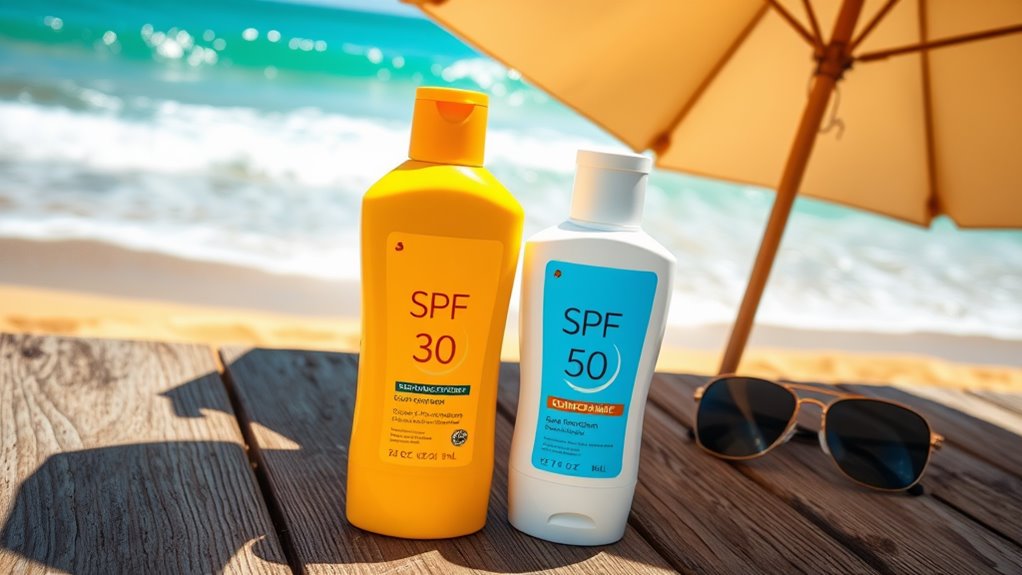SPF 30 vs. SPF 50 – Which One Should You Choose.
When choosing between SPF 30 and SPF 50, think about your sun exposure and skin type. SPF 30 blocks about 97% of UVB rays, while SPF 50 blocks roughly 98%. If you have fair skin or plan to spend long hours outdoors, SPF 50 might be a better choice for protection. For everyday activities, SPF 30 is typically sufficient. Make sure to apply it properly and reapply every two hours for the best results. There’s more to learn about finding the right fit for your needs.
Understanding SPF: How It Works
When you pick a sunscreen, understanding SPF (Sun Protection Factor) is crucial. SPF measures how well a sunscreen can protect your skin from harmful UV rays. For instance, if you usually burn after 10 minutes in the sun, an SPF 30 sunscreen theoretically allows you to stay protected for 30 times longer—about 300 minutes—before burning.
It’s important to note, though, that no sunscreen offers complete protection.
When making an SPF comparison, consider your skin type and the amount of time you’ll spend outdoors. Higher SPF doesn’t always mean significantly better protection, but it does offer added peace of mind, especially for those with fair or sensitive skin. Additionally, the effectiveness of higher SPFs can diminish if not applied properly or reapplied frequently throughout the day.
UV Protection Levels: SPF 30 vs. SPF 50
SPF 30 and SPF 50 both provide effective protection against harmful UV rays, but the difference in their effectiveness can be notable. You may wonder how much more protection SPF 50 truly offers. The numbers indicate percentages of UVB rays blocked; the higher the SPF, the more protection you get. Here’s a quick comparison:
| SPF Level | Percent of UVB Blocked | Ideal Use Case |
|---|---|---|
| SPF 30 | 97% | Daily activities |
| SPF 50 | 98% | Extended sun exposure |
While SPF 30 blocks about 97% of UVB rays, SPF 50 blocks roughly 98%. The difference might seem small, but it can make a big impact if you’re spending long hours outside. Choosing the right SPF isn’t just about numbers; it’s about keeping yourself and your loved ones protected. You belong to a community that values skin health, so make informed choices!
Application Guidelines: Timing and Quantity
Choosing the right SPF is just the beginning; how you apply it can make a significant difference in protection. To maximize your sunscreen’s effectiveness, timing and quantity are key.
Put sunscreen on at least 15 minutes before heading outdoors, allowing it to fully absorb into your skin. Don’t forget the often-missed spots like ears, feet, and the back of your neck.
When it comes to quantity, aim for about a shot glass full—roughly one ounce—for full-body coverage. For your face and neck, a nickel-sized amount should do the trick.
Remember to reapply every two hours, or more often if you’re sweating or swimming. Make this a part of your routine, and you’ll not only protect yourself but also create a shared experience with family and friends when you’re all enjoying the sun together.
Your skin will thank you for it!
Effectiveness for Different Skin Types
While all skin types need protection from the sun, the effectiveness of sunscreen can vary based on individual characteristics.
If you have fair skin, you might find that SPF 50 offers more reliable protection against sunburn, helping you feel more secure during outdoor activities. On the other hand, if your skin is darker, you may not need as high an SPF, but it’s still essential to apply sunscreen to prevent skin damage.
For sensitive skin, both SPF 30 and SPF 50 can work, but you’ll want to opt for fragrance-free and hypoallergenic formulas to minimize irritation.
Oily or acne-prone skin types might benefit from lighter, non-comedogenic options available in both SPF categories.
Ultimately, it’s about finding a sunscreen that feels right for you and your lifestyle while fostering a sense of community around protective skincare.
Everyone deserves to enjoy the sun safely!
Choosing the Right SPF for Your Needs
How can you determine the right level of sun protection for your unique lifestyle? Start by considering your daily activities and how much time you spend outdoors.
If you’re an outdoor enthusiast or working on a sunny job site, SPF 50 might be your best friend, offering more robust defense against harmful UV rays. On the other hand, if you’re mostly in the shade or indoors, SPF 30 could be enough to keep your skin protected without feeling heavy.
Also, think about your skin type and personal preferences. If you have sensitive skin, look for broad-spectrum options with nourishing ingredients.
Don’t forget to reapply every two hours, regardless of your chosen SPF. Remember, sun safety isn’t just about numbers; it’s about feeling secure in your skin, fitting in with like-minded friends who prioritize health, and enjoying time outdoors with confidence.
Choose wisely, and you’ll be ready for whatever the sun throws your way.

